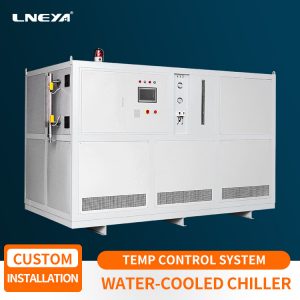How does the Industrial Water Chiller System Work?
When using industrial machinery, a cooling system may be required to prevent the machine from overheating. Refrigeration equipment can effectively keep materials in the optimal temperature range, but how does the chiller work? Understanding the working principle of industrial water chiller is very helpful to select the best refrigeration system to meet the needs of users.

Working principle of industrial water chiller
In short, industrial water chillers cool process fluids. Process fluid (usually water or water / glycol mixture) is used to cool machinery, equipment, etc. The process fluid absorbs heat from the cooled object and then passes through the chiller, where the heat is removed from the fluid and transferred to the ambient air.
Refrigeration circuit
The industrial water or glycol chiller system consists of two main circuits: refrigeration circuit and fluid circuit. The refrigeration circuit consists of four parts: compressor, condenser, expansion valve and evaporator. The refrigeration circuit removes heat from the process fluid. The fluid circuit usually consists of fluid reservoir, pump, filter and heat exchanger. The fluid circuit carries process fluid around the cooled object.
Refrigeration cycle steps:
Refrigeration circuit is the most technical part of the working mode of chiller. The refrigeration cycle uses the principle of thermodynamics to effectively transfer heat from one region to another. In the case of a chiller, heat is extracted from the cooled fluid and transferred to the ambient air.
Compressor
The refrigeration cycle starts with the compressor. The compressor uses gaseous low-pressure and low-temperature refrigerant to compress it into high-pressure and high-temperature gas.
Condenser
The gas then flows through the coils in the condenser. In the condenser, air or water will flow through the coil and remove heat from the refrigerant. As the refrigerant loses heat, it will begin to condense until all the gases condense into a liquid.
Expansion valve
After leaving the condenser, the liquid passes through the expansion valve. The expansion valve limits the flow of refrigerant. When the high-pressure liquid passes through the expansion valve, it enters the evaporator.
Evaporator
The evaporator is where the refrigerant begins to evaporate. When the refrigerant evaporates, it becomes very cold and absorbs a lot of heat. The process fluid will interact with the cold refrigerant in the evaporator. Heat is removed from the fluid and transferred to the refrigerant. The refrigerant then enters the compressor and the cycle begins again.
Related recommendations
-
Explosion-proof hot and cold machine winter maintenance instructions
1200When the explosion-proof type hot and cold integrated machine is used at the end of the day or when it is not used by the standby, be sure to disconnect the cooling water connection pipe, clean the remaining cooling water in the pipe, and store it...
View details -
Reactor thermostat heating circulation equipment
742Reactor thermostat heating circulation equipment is a kind of equipment used to accurately control the temperature in the reactor during the chemical reaction process to ensure that the chemical reaction can be carried out under the set te...
View details -
16. – 18. June 2020 | The Automotive Testing Expo Europe-LNEYA
1361The Automotive Testing Expo Europe is a trade fair for automotive test, evaluation and quality engineering. It is one of the most important event of its kind in Europe.The fair widtmet the latest technologies and services to improve quality, safet...
View details -
Performance Characteristics of 30 HP Water Cooled Chiller
1051The 30p water cooled chiller is an industrial water chiller with a horsepower of 30 HP. The water-cooled industrial water chiller must rely on the cooling water tower for work, while the air-cooled industrial water chiller uses its own fan for coo...
View details
 LNEYA Industrial Chillers Manufacturer Supplier
LNEYA Industrial Chillers Manufacturer Supplier












